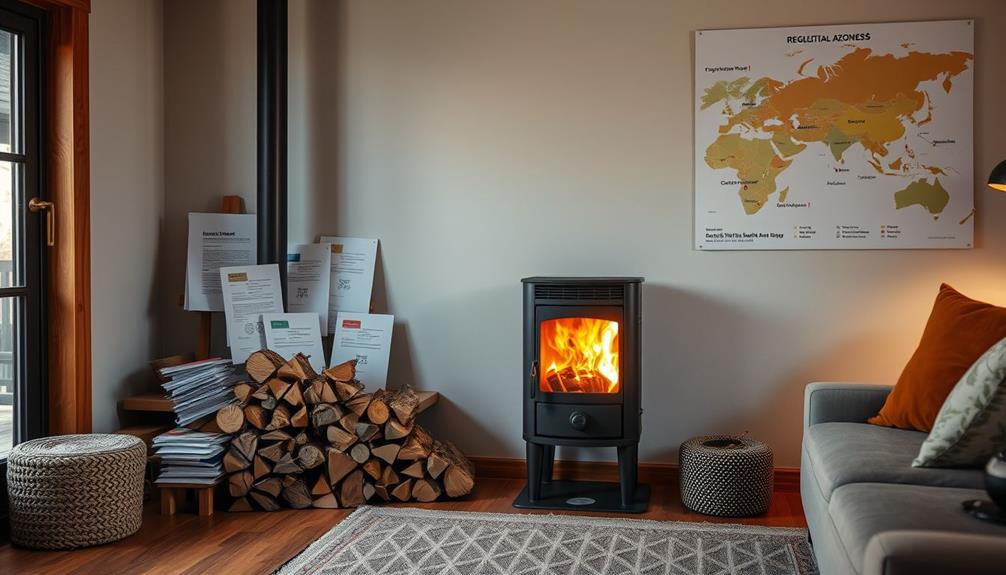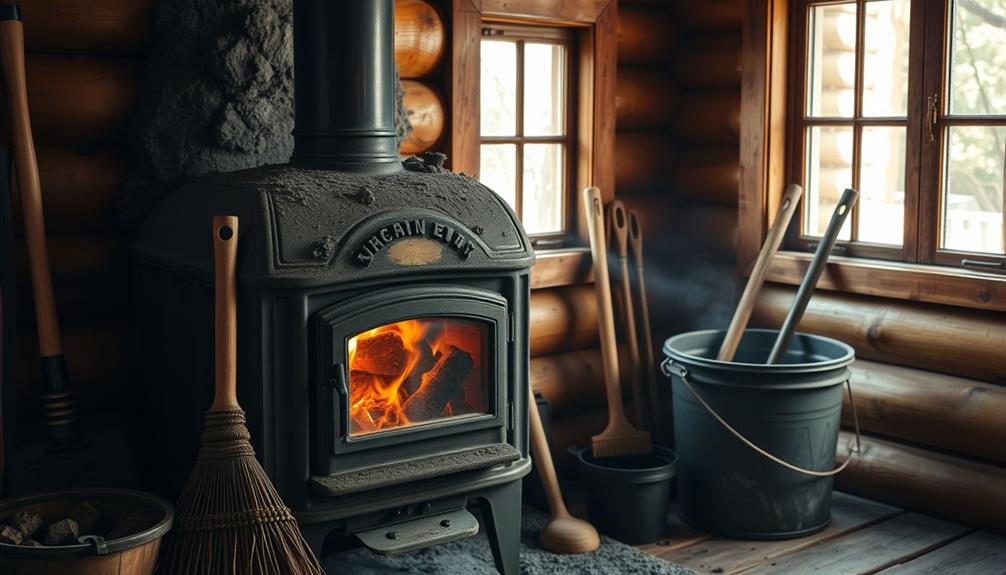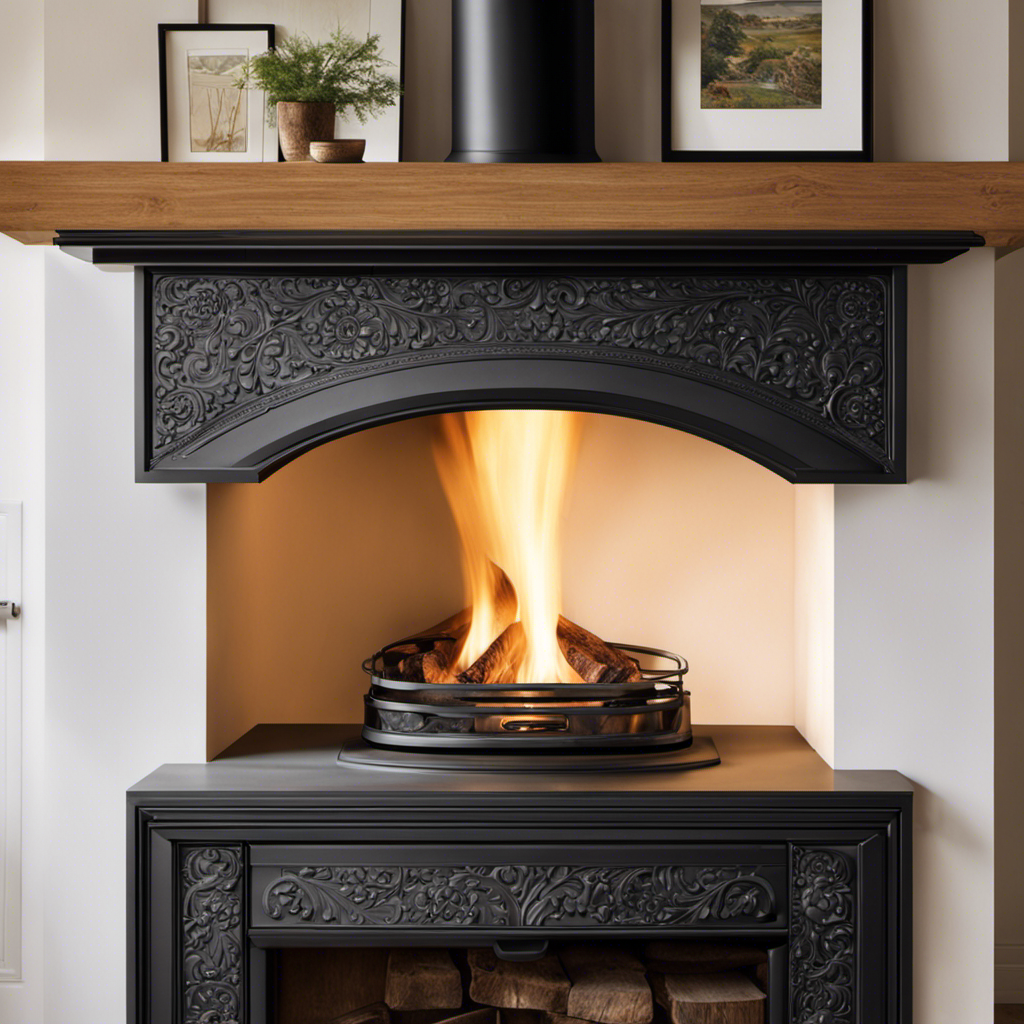Staying compliant with wood stove regulations is vital for you and your community's air quality. Begin by checking if your stove meets the EPA's emission limits, like the step 2 standard of 2 grams of smoke per hour for new wood heaters. Local regulations may impose stricter standards, so consult your area's Department of Environmental Quality. Regularly updating yourself on local ordinances, especially concerning burning restrictions and older stove regulations, is essential. By knowing the rules, you can avoid penalties and help protect the environment. There's more to explore about maintaining compliance and improving your wood-burning practices.
Key Takeaways
- Ensure your wood stove meets EPA's New Source Performance Standards, which limit emissions to 2.0 grams of smoke per hour for new models.
- Check local regulations, as state and municipal laws may impose stricter emission standards than federal requirements.
- Look for EPA-certified wood stoves, which indicate compliance with necessary emission standards and higher efficiency.
- Stay informed about local burn bans and air quality alerts to avoid penalties and protect community health.
- Consult your local Department of Environmental Quality for specific compliance rules and updates regarding wood-burning appliances.
Overview of Wood Stove Regulations
Wood stove regulations are essential for guaranteeing cleaner air and safer heating methods. The EPA's New Source Performance Standards (NSPS) set strict emission limits for new residential wood heaters. As of May 2020, these regulations require new wood stoves to produce no more than 2 grams of smoke per hour. This update, along with the 2015 amendments, aims to reduce pollution and enhance compliance monitoring for wood-burning appliances.
Additionally, understanding the benefits of investment diversification can help homeowners allocate resources for upgrading to more efficient heating options.
These regulations specifically target wood stoves, pellet stoves, wood-fired hydronic heaters, and indoor wood-fired forced air furnaces. Existing heaters in homes are exempt from these standards, but it's still important to reflect on the efficiency and emissions of your current unit.
To guarantee you're making a responsible choice, look for EPA-certified wood stoves. These models meet stringent emission standards and are generally more efficient than older versions.
Additionally, don't forget to check local and state regulations, which may impose stricter requirements than the EPA standards. Being informed about these rules helps you choose the right wood-burning appliance while contributing to cleaner air in your community.
Staying compliant guarantees a safer and more efficient heating method for your home.
Understanding NSPS and Emission Limits
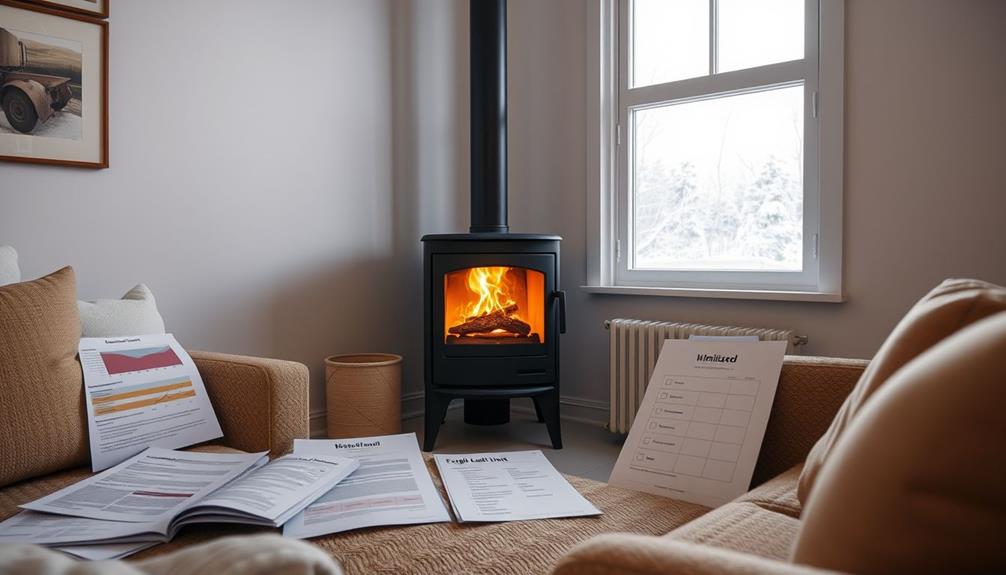
When it comes to wood stoves, understanding the New Source Performance Standards (NSPS) and their emission limits is essential for both consumers and manufacturers.
These regulations were designed to reduce harmful particulate matter emissions, with specific limits established for different types of wood.
Additionally, consumers should consider the efficiency of their heating systems, as heat pump technology advancements can provide cleaner alternatives.
You'll want to stay informed about compliance monitoring requirements to guarantee your stove meets the latest standards.
NSPS Overview and Purpose
The New Source Performance Standards (NSPS) play an essential role in regulating emissions from new residential wood heaters, aiming to enhance air quality and protect public health. Established by the EPA, these standards focus on reducing particulate matter (PM) emissions from wood stoves.
Efficient waste disposal methods are vital for maintaining a healthy environment, much like how these standards aim to minimize emissions. Here's what you need to know about the NSPS:
- Emission Limits: The NSPS introduced a Step 1 limit of 4.5 grams of PM per hour in 2015, followed by a more stringent Step 2 limit of 2.0 grams per hour in 2020 for crib wood.
- Alternative Compliance: For cord wood, an alternative limit of 2.5 grams per hour is set, with ongoing testing method development to guarantee compliance.
- Quality Assurance: Manufacturers must maintain quality assurance to meet these clean air standards, emphasizing the need for cleaner-burning technologies.
Approximately 90% of wood stoves already meet the Step 1 limit, and many top-performing models comply with the stricter Step 2 limits.
Emission Limit Details
Guiding through the specifics of emission limits set by the New Source Performance Standards (NSPS) is vital for anyone using wood stoves. Effective May 15, 2015, the NSPS established a particulate matter (PM) emission limit of 4.5 grams per hour. This limit was further tightened to 2.0 grams per hour for crib wood starting May 15, 2020.
For those burning cord wood, an alternative compliance standard sits at 2.5 grams per hour, with the EPA actively developing testing methods to guarantee adherence. Understanding the significance of maintaining compliance can be likened to the necessity of regular maintenance in other devices, such as a self-cleaning brush roll that promotes ideal performance.
As of 2010, around 90% of wood stoves manufactured already met the Step 1 limit, and many high-performing models comply with the stricter Step 2 limits. It's important to recognize that manufacturers must maintain quality assurance processes to meet these emission limits. This may lead to increased production costs, which can affect retail prices for wood-burning appliances.
To help you identify compliant products, the EPA provides a list of certified units that meet these emission limits. Choosing a certified wood stove not only keeps you in compliance but also promotes safer use for the environment and your community.
Compliance Monitoring Requirements
Understanding the compliance monitoring requirements for wood stoves is key to guaranteeing that your appliance not only meets emission limits but also operates efficiently.
The EPA regulations, particularly the New Source Performance Standards (NSPS), set strict emission standards that your wood stove must adhere to. Additionally, it's crucial to stay informed about market trends that may impact wood stove technology and efficiency.
Here are some important points to keep in mind:
- Emission Limits: New wood stoves must meet 4.5 grams per hour (Step 1) as of May 15, 2015, and 2.0 grams per hour (Step 2) as of May 15, 2020, for crib wood.
- EPA-Certification: Confirm your stove has an EPA-certified label, indicating it meets the required emission standards. You can find a list of compliant products on the EPA's website.
- Ongoing Compliance Monitoring: Manufacturers are responsible for continuous testing and quality assurance to maintain compliance with the NSPS, promoting improved technology and more efficient wood stoves.
Types of Regulated Wood Heaters
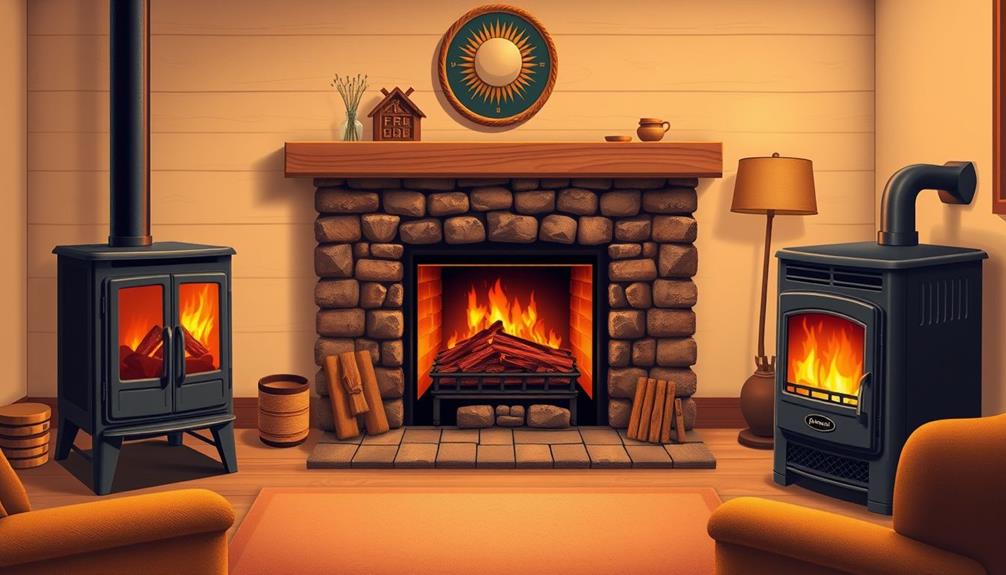
When it comes to regulated wood heaters, several types fall under the New Source Performance Standards (NSPS). These standards were designed to promote cleaner air and cover new residential wood heaters, which include woodstoves, pellet stoves, wood-fired hydronic heaters, and indoor wood-fired forced air furnaces.
Utilizing renewable energy sources, such as geothermal or solar power, can complement wood heating systems by reducing overall emissions and enhancing energy efficiency eco-friendly and reliable energy source.
To guarantee compliance, manufacturers must provide EPA-certified labels on wood stoves. This certification ensures that the heaters meet strict emission limits set forth by the Clean Air Act. Specifically, there are PM emission limits that you need to be aware of: a Step 1 limit of 4.5 grams per hour took effect on May 15, 2015, followed by a stricter Step 2 limit of 2.0 grams per hour that became mandatory after May 15, 2020.
It's important to note that single burn-rate woodstoves are specifically addressed under these regulations, but they don't apply to existing heaters in your home.
State and Local Compliance Requirements
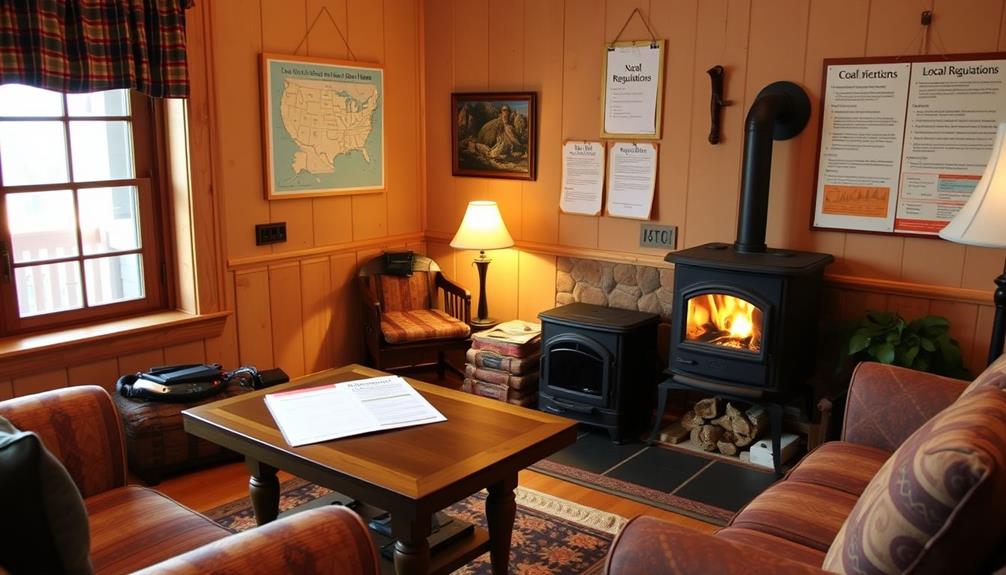
When it comes to wood stove regulations, you need to pay attention to both state and local compliance requirements. Some areas have stricter emission standards or unique local ordinances that could affect your heating options.
It's crucial to be aware of the environmental impact of your heating methods, particularly regarding air quality and emissions, as these factors can influence local regulations. To stay compliant, make sure to check with your local Department of Environmental Quality for any specific rules that apply to you.
Additionally, understanding the impact of plumbing issues related to improper waste disposal can help you make informed choices about your home's heating systems.
Local Ordinance Variations
Local ordinances regarding wood stove regulations can vary considerably, and it's vital to be aware of these differences before making a purchase.
Compliance with local laws is imperative, as these regulations can greatly impact your ability to use a wood stove. Additionally, using an air purifier can help improve indoor air quality, especially in areas where wood burning is prevalent.
Here are three key variations you should consider:
- Burning Restrictions: In areas like Albuquerque, NM, and the Bay Area, CA, local ordinances may restrict wood burning during specific air quality alerts or emergencies.
- Older Stove Regulations: Missoula County, MT, requires the removal of older stoves upon property ownership changes in designated Air Stagnation Zones to minimize pollution.
- Advisory Mandates: In Colorado, burning restrictions are mandated during red advisories in the Denver-Boulder area to improve air quality.
Always check your local ordinances to confirm compliance with both state regulations and emissions standards.
Ignoring these rules could lead to fines or complications down the line. By staying informed, you can make a responsible choice that aligns with local wood stove regulations and protects your community's air quality.
Emission Standards Compliance
Understanding your area's emission standards is just as important as knowing local ordinances regarding wood stoves. Compliance with the New Source Performance Standards (NSPS for Residential Wood) is vital. New wood-burning appliances must meet a particulate matter emission limit of 2 grams/hour, or 2.5 grams/hour for cordwood, following the May 2020 deadline.
Additionally, awareness of potential credit card trends can help you manage expenses related to purchasing compliant appliances.
States can impose regulations that are equal to or even stricter than EPA standards, as seen in Washington, which has enforced stricter emission rules since 1995. Additionally, local laws may introduce further restrictions on wood stove use, such as mandatory burn bans during high pollution days or banning the sale of uncertified wood stoves.
To avoid fines and guarantee compliance, it's important to check with your local Department of Environmental Quality or similar authorities. They can provide specific regulations concerning your wood-burning appliances and help you understand the necessary steps to stay compliant with emission standards.
Amendments to Existing Regulations
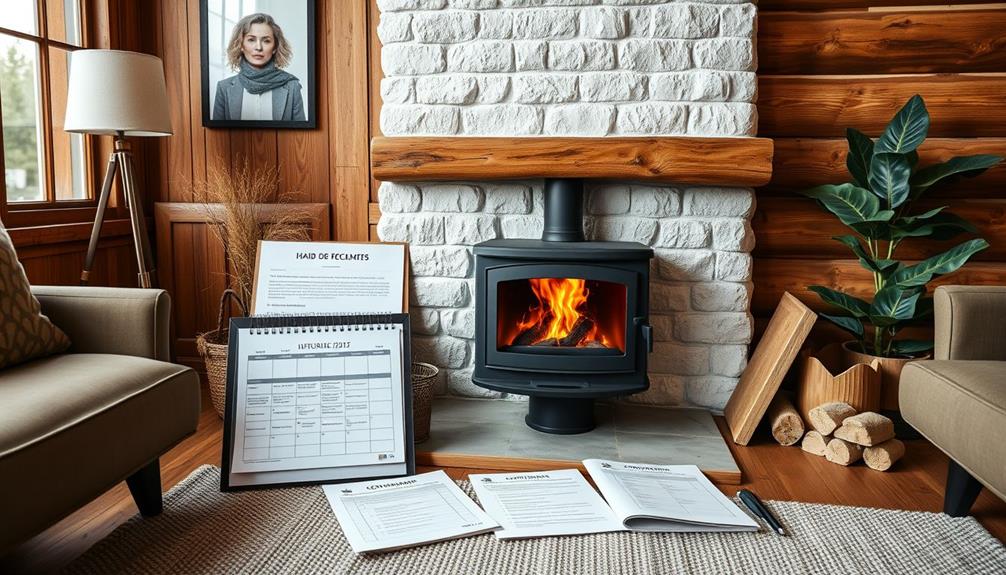
Recent amendments to the New Source Performance Standards (NSPS) greatly enhance the emission standards for new residential wood heaters, including wood stoves and hydronic heaters. Finalized on March 11, 2020, these revisions introduce stricter limits aimed at reducing air pollution.
These changes reflect a broader trend towards sustainability and responsible investment, akin to the way diversification of retirement savings is encouraged through gold investments.
Here are three key points about the amendments:
- Stricter Emission Limits: New wood stoves must meet a Step 2 limit of 2.0 grams of particulate matter per hour, effective after May 15, 2020. This is a significant reduction that promotes cleaner burning technology.
- EPA Certification Requirement: The amendments reinforce the need for wood stove labels to indicate EPA certification, making it easier for you to identify compliant products. This guarantees you're investing in a stove that meets rigorous emission standards.
- Focus on Air Quality: Continuous improvements in wood heater technology are emphasized, further enhancing air quality. Manufacturers are encouraged to adopt practices that reduce emissions and align with these updated standards.
Monitoring and Certification Processes
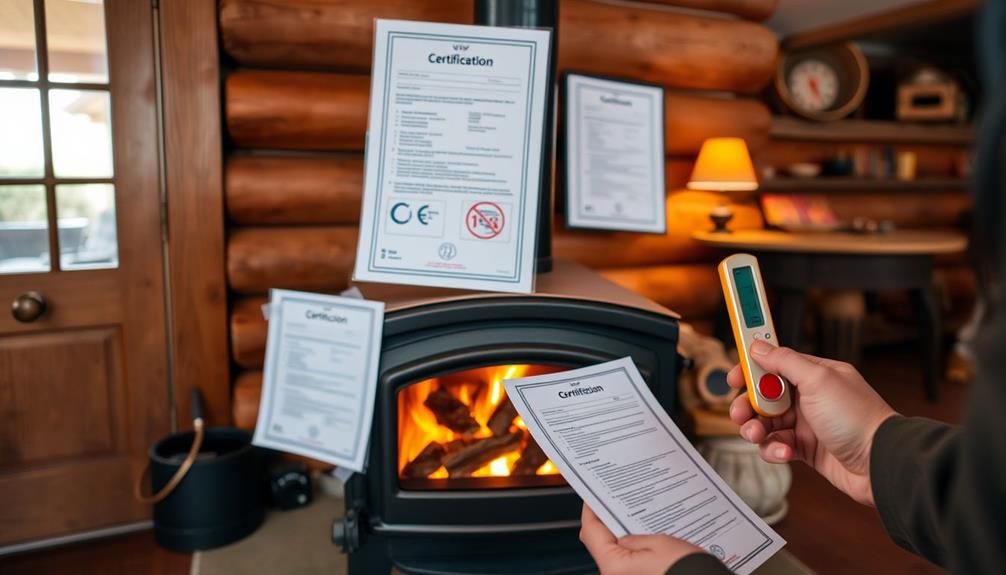
How can you be confident that the wood stove you're considering meets the latest emission standards? The Environmental Protection Agency (EPA) mandates that all newly manufactured wood stoves comply with the New Source Performance Standards (NSPS).
These standards include specific emission limits and rigorous testing protocols to guarantee that the products on the market are safe and efficient. To enhance your home's energy efficiency and reduce operational costs, consider models that integrate modern technology and smart features, similar to garage door openers.
When shopping, look for the EPA-certified label on wood stoves; this label indicates that the model meets the established emission standards. The EPA also provides a thorough list of certified wood stoves on its website, giving you a reliable resource to verify compliance before making a purchase.
Additionally, manufacturers are responsible for adhering to certification requirements and implementing quality assurance measures throughout the production and distribution processes.
To maintain compliance, the EPA runs an ongoing compliance monitoring program that regularly assesses the performance of certified wood heaters. This program guarantees that these stoves continue to meet the required emission standards over time, giving you peace of mind as you choose the right wood stove for your home.
Emission Reduction Initiatives
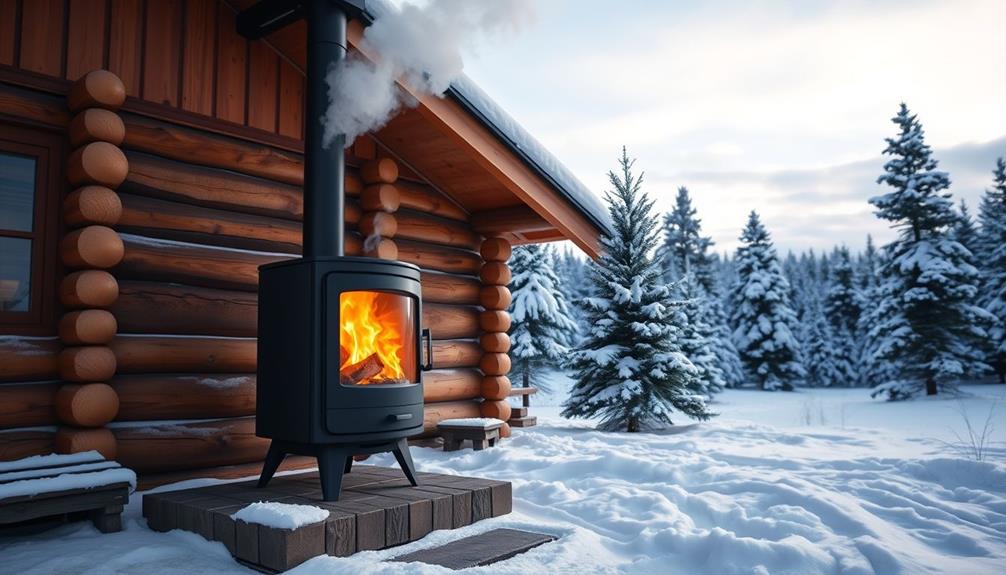
Wood smoke drifts through the air, a reminder of the need for cleaner alternatives in residential heating.
To tackle air pollution and enhance public health, various emission reduction initiatives are in place, guiding you toward more environmentally friendly practices.
Here are three key strategies:
- Replace Old Wood Stoves: Programs like the Environmental Law Institute's report stress replacing older wood-burning devices with newer models that meet EPA standards, considerably reducing harmful emissions.
- Participate in Local Programs: Initiatives such as the Yolo-Solano Air Quality Management District's "Don't Light Tonight" campaign encourage you to minimize wood burning when air quality levels are unhealthy, promoting clean burning practices.
- Follow State Regulations: In places like Oregon, regulations prohibit the sale of uncertified wood stoves, ensuring all new heating devices comply with established emission standards.
Burn Bans and Air Quality Measures

As communities endeavor for cleaner air, burn bans play an important role in managing pollution levels, especially during periods of high smog and stagnation. These regulations, enforced by agencies like the Southwest Clean Air Agency (SWCAA) in Washington, prohibit wood burning to protect air quality. Understanding the different stages of burn bans is significant; Stage 1 bans restrict all fireplaces and uncertified wood stoves, while Stage 2 bans extend to all wood heating devices, including certified units.
| Impact of Burn Bans | Community Benefits |
|---|---|
| Reduced emissions | Improved respiratory health |
| Better visibility | Enhanced outdoor activities |
| Healthier ecosystems | Stronger community engagement |
When air quality alerts occur, the EPA advises residents to avoid using wood stoves and fireplaces, unless they're the sole heat source. This is critical in areas like Albuquerque, NM, and the Bay Area, CA, where local ordinances actively regulate wood burning during specific weather conditions. By adhering to burn bans, you contribute to a healthier environment and help guarantee cleaner air for everyone.
Resources for Homeowners and Businesses

Accessing reliable resources is essential for homeowners and businesses looking to navigate wood stove regulations effectively. Here are some key resources to help you stay compliant:
- EPA Certified Wood Stoves: Make certain your wood stove meets the latest emission standards set by the EPA. Check their list of certified models to guarantee compliance with the New Source Performance Standards established in 2015.
- Department of Environmental Quality: Local regulations can be stricter than EPA standards. Always consult your local Department of Environmental Quality for specific rules regarding wood stove use and emissions in your area.
- Burn Wise Home Program: This program offers educational resources and guidance on wood smoke regulations. It helps you make informed decisions about your heating options and understand the impact of your choices.
Additionally, don't overlook financial incentives. Some states provide tax deductions for homeowners who upgrade to newer, EPA-certified models.
If you're a small business, check out the Small Entity Compliance Guide from the EPA. It simplifies understanding wood stove emissions standards, assuring you adhere to the law.
Frequently Asked Questions
What Makes a Wood Stove EPA Compliant?
A wood stove's EPA compliance hinges on meeting strict emission limits, undergoing independent testing, and displaying a certification label. This guarantees you enjoy efficient heating while contributing to improved air quality and reduced environmental impact.
Can You Put a Wood Burning Stove Anywhere?
You can't just put a wood burning stove anywhere. In fact, about 60% of states have specific placement rules. Always check local regulations and verify you maintain clearances to prevent fire hazards and emissions issues.
What Is the Clearance Around a Wood Burning Stove?
To guarantee safety, maintain at least 36 inches of clearance around your wood burning stove from non-combustible surfaces. For combustible materials, increase that distance to 48 inches or more, depending on your stove's specifications.
How Far Does a Wood Stove Need to Be Away From a Protected Wall?
When you install a wood stove, you need to maintain at least 12 inches from a protected wall. If you use wall protection materials, you might be able to reduce that distance further. Stay safe!
Conclusion
Staying compliant with wood stove regulations may seem challenging, but it's essential for both your health and the environment. You might worry that meeting these standards is too costly or complicated, but many local programs offer assistance and incentives to help ease the burden. By understanding your responsibilities and taking proactive steps, you can enjoy the warmth of your wood stove while contributing to cleaner air. Embrace these regulations as a pathway to a healthier community for everyone.

